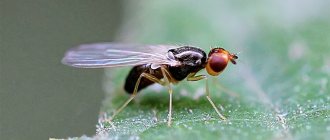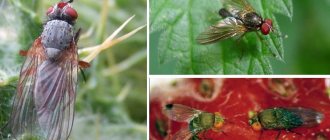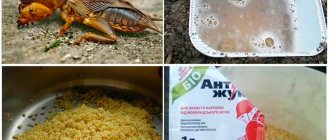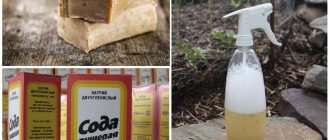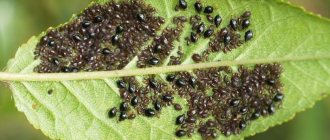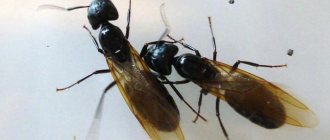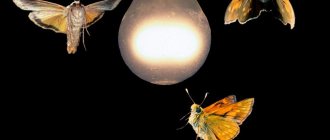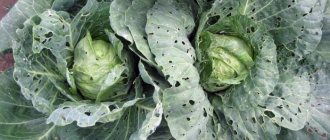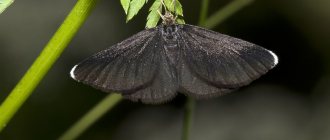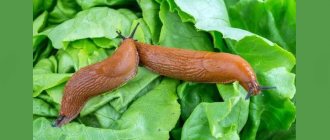Cabbage moth
Cabbage moth is one of the main pests of cruciferous crops . Its danger is confirmed by the fact that in some years in fields and private plots the insect is able to squeeze out its competitors in the fight for food - cruciferous flea beetle, rapeseed leaf beetle, cabbage aphid.
Description of the pest
An adult insect is a small butterfly with narrow wings of various colors. Shades vary from brown-gray to dark brown.
On the front wings, a light yellow or white wavy stripe runs along the rear edge, forming a diamond-shaped pattern when the wings are folded. The hind wings are gray-silver with long fringes along the edges.
The pest lays small, slightly flattened eggs . After laying, they are colored white-yellow with dark dots, and over time they become lemon-yellow.
The body of the larvae (caterpillars) is 7–12 mm long, has a spindle-shaped shape - it is narrowed in front and behind. Young larvae are white with a brown head. As they develop, after 3–4 molts, their body turns light green or dark brown, sparse dark bristles appear, and dark spots appear on the head. The caterpillars are mobile and move on 16 legs.
Caterpillars complete their development by turning into pupae. This process occurs on plants; yellow or green pupae are protected by an elongated gray-white cocoon.
Bacterial preparations
Contains toxins and bacterial spores. The substances are not dangerous to human and animal health. They have a long-lasting effect. They remain on the surface of the leaf and enter the larvae after eating. The greatest results can be achieved at the peak of caterpillar activity - at +16 degrees Celsius. There is no re-infection. The action begins immediately, but death is observed after 3-5 days.
- Entobacterin – a 0.5% solution is prepared;
- Bactospein – 0.3%;
- Dendrobacillin – 0.15%;
- Dipel – 0.2%;
- Bitoxibacillin – 0.15%;
- Gomelin – 0.15%;
- Lepidocide – 0.15%.
The product acts exclusively on caterpillars. Disappearing into the intestinal tract, it causes paralysis and death.
Life cycle
In the central zone, the appearance of the pest occurs at the end of April, in the south - at the beginning of April, and in the northwestern and eastern regions, insects begin to fly in May-early June.
They are active in the late evening or at night, and during the mating period they are visible during the day. Insects do not rise into the air higher than 2 m and do not fly long distances on their own. The wind carries them for many kilometers.
Female cabbage moths lay an average of 80–170 eggs. They attach them along the veins on the bottom of the leaf or at the base of the petioles. After 3–6 days, voracious caterpillars emerge from the eggs.
They live for 10–15 days, feeding inside the leaves for the first 2–3 days, and then emerging to the surface. During this period, the first molt occurs. In total, the caterpillar molts 3–4 times every 2–3 days. Before each time, the larva weaves a protective cover, which is attached to the underside of the leaf, then climbs under the canopy and only then moults.
Caterpillars have a good reaction; at the slightest danger, they begin to wriggle, curl into an arc and descend from the leaf to the ground on a web. A white cocoon is constructed from the same silk threads, in which pupation takes place. This stage lasts 7–15 days. The pupae can withstand low temperatures and remain over the winter, turning into butterflies in the spring of the following year .
Depending on temperature conditions, the development of one population takes 35–40 days . Females live 1 month, males live 20 days. In just one season, 3–4 generations of the pest may appear.
Why does a caterpillar appear on cabbage?
A butterfly goes through several stages in its development: egg, caterpillar larva, pupa, and adult. To find a suitable object for laying eggs, she explores the area and, if they appear in the garden, you can expect to lay a clutch. She does this several times during the season. The insect is active in dry, sunny, warm weather.
Cabbage caterpillars are larvae that hatch from eggs laid on the underside of the leaf, making them invisible. To enter the pupal stage, they require a large amount of food, so after hatching, they immediately begin to “work”.
Reasons contributing to the appearance of caterpillars:
- the rules of crop rotation were violated - in one place cabbage can be planted again after 2-3 years, since pathogens accumulate in the soil, pest larvae remain, cabbage cannot be planted after beets, radishes, turnips, early potatoes, and other types of cabbage;
- Fertilizers were applied incorrectly or not at all, and the plant is weakened;
- on the site, next to it there is a lot of weeds where insects settle;
- preventive measures were not taken to prevent infections and insect damage;
- the rules for preparing the soil were not followed - the site must be dug up in the fall using a spade so that the larvae of pests overwintering in the soil die in the frost;
- the rules of agricultural technology were violated, so the plants are weak, frail and become easy prey for pests;
- In the fall, tops and grass were left on the site - pests and pupae overwinter in them.
Signs of a pest
A small caterpillar at the laying site (it is clearly visible) immediately begins to eat the lower surface of the leaf and gnaws small holes, then crawls further. As it grows, it moves to the upper part, the area of the holes increases, photosynthesis is disrupted, and the leaf loses its elasticity. The presence of holes and a limp, weak leaf are signs of the presence of a pest. It can be detected by normal inspection of the sheet from below and above.
The caterpillar leaves behind excrement, which negatively affects photosynthesis processes, provokes fungal infections, and poisons tissues with toxins. If there are a lot of caterpillars, then soon only veins remain from the leaves, and the insect moves to a young, succulent head of cabbage. The growth of the plant stops, and a large head of cabbage will no longer grow
Therefore, it is important to know how to care for cabbage in open ground so that there is a good harvest.
What butterflies lay eggs on cabbage
Several species of butterflies lay eggs, and there may be clutches of more than one species on one plant. Butterflies do not appear at the same time, so you can find both eggs and caterpillars at different stages of development on cabbage.
Types of cabbage butterflies:
- Cabbage moth. At the end of April-May, small butterflies with brown wings (like a moth) appear from overwintered pupae; after 1-2 weeks they make their first clutches. Flight time is from late April to mid-September. The young caterpillar (1 cm) is light, almost without pigmentation, the color of the head is brown; the color of the adult is green, dark or light brown. The caterpillars move quickly, and when in danger they bend and fall off the leaf. During the head formation stage, the inner leaves are damaged and the top bud is eaten away. The life cycle is 10-15 days, then pupation occurs on the plant, and after 1-2 weeks a butterfly appears.
- Belyanka (cabbage). The butterfly is large, with a black border on the white wings. They appear only on a sunny day. The caterpillar is yellow-green in color, its body covered with black spots and covered with hairs. Eats the pulp of leaves, leaving only the veins. Flight time is from May to August.
On a note!
The turnip white butterfly is similar to the cabbage butterfly, but smaller in size.
- Ognevka. The wingspan is about 3 cm, eggs are laid on warm nights. You can recognize it by the color of its wings: light, with patterns, with yellow-brown streaks along the edges. Flight time is from May to June; in the south they appear in August. Light yellow caterpillars appear after 1.5 weeks, young ones eat through the windows in the leaf, adults gnaw through the head of cabbage.
- Scoop (noctule). Overwinters as a larva or pupa. A small brown-gray motley butterfly hides during the day and lays eggs at night; you can attract it to the light. Flight time is from May to October. Young larvae are green, live in groups, and eat the leaf from below. An adult (5 cm long) is brown, has a yellow stripe running along the sides of the body, and gnaws the head of cabbage, littering it with excrement. A head of cabbage poisoned by toxins begins to rot and is not suitable for consumption.
What does the affected plant look like?
The eggs of the pest attach to the underside of the leaf, and the hatched larvae immediately penetrate the leaves and eat away the internal tissues . They make short moves (mines), but do not damage the skin.
After 2–3 days, the caterpillars switch to open feeding and eat holes in the leaves . As the larvae develop, these holes increase in size. During mass infection, plants lose all leaf tissue, leaving only veins .
Often the pest completely eats up the stems and seeds. In cabbage heads, caterpillars climb into the center and destroy the apical bud along with the leaves . As a result, plants lag behind in development, become deformed and the yield decreases.
Why is cabbage moth dangerous?
If you do not fight butterflies, you can instantly lose your crop. The main danger lies precisely in this.
The butterfly's flight occurs at dusk or at night. If you see them flying even during the day, this is a sign that there are too many pests and urgent action needs to be taken. Or rather, it is not the butterflies themselves that cause harm to plants, but their larvae - small green caterpillars, which very quickly, because there are so many of them, first eat out small holes in the cabbage leaves.
In addition to damaged leaves, the presence of a pest is indicated by the following signs:
- spots on the leaves,
- corroded bud of a head of cabbage,
- the leaves begin to dry out
- poor plant growth.
A large number of caterpillar larvae and lost time can lead to the fact that the entire leaf and ovary of the head of cabbage will be completely eaten, leaving only the veins.
As a result of such an invasion of pests, the marketable appearance is lost, the vegetable is poorly stored and quickly deteriorates. Plants are especially severely affected in hot weather.
Causes of the pest
The appearance of cabbage moths is cyclical and depends on climatic conditions (temperature and humidity). It has been established that the massive spread of the pest is observed in years when winters were warm and humid . This promotes the early development of cruciferous weeds, which become a food source for the first generation of caterpillars. Further accumulation of positive temperatures contributes to the successful development of the first generation and the appearance of the second population of the pest at the end of June.
In hot and dry summers, the cabbage moth in some regions becomes the main pest of cruciferous crops.
It was also noted that a sharp increase in the number of the pest occurs after 6–8 years of continuous cultivation of plants in one place.
Preventive measures
Cabbage plantings must be periodically inspected, and when caterpillars first appear, they must be collected manually, and then processed. To minimize risks, it is recommended to follow proven preventive methods:
- When planting, rapeseed seeds are treated with an insecticide solution - this measure to combat cabbage moths is especially effective.
- Compliance with crop rotation - cabbage is grown in one place for a maximum of three years in a row. Then the field or bed needs to be changed.
- It is better to plan planting cabbage crops in places where cucumbers, legumes, pumpkins and zucchini were recently grown. All cruciferous vegetables are bad predecessors, since they share common pests, including cabbage moths. It is also not recommended to plant cabbage after carrots, beets and nightshades (bell peppers, tomatoes, eggplants).
- The natural enemies of cabbage moths are birds, so birdhouses and nest boxes can be placed on the site.
- Melissa, parsley, celery, coriander and other fragrant herbs are planted next to the beds. They can also be used for mulching plantings (along with fresh pine needles).
- Experienced summer residents advise covering cabbage plantings with agrofibre to prevent butterflies from laying eggs.
- Since cabbage moth infestation cannot be completely eliminated, it is necessary to monitor the first signs of its appearance. To do this, sticky traps are placed next to the garden bed, on which butterflies land.
- Thorough autumn garden cleaning. The area is completely cleaned, removing the cabbage tops and stalks, since cabbage moths very often appear there.
What crops are affected by the pest?
The cabbage moth damages all cruciferous crops . In nature, it attacks wild radish, shepherd's purse, rapeseed, wild rapeseed, field reddish, and wildflower .
The pest has special preferences among cultivated plants. Larvae and butterflies feed on all types of cabbage. They love rapeseed, mustard, radishes, turnips, rutabaga, horseradish, turnips .
The pest is especially dangerous for young plantings. Due to damage to the central sockets, they may completely die.
Popular measures
Various types of chemicals are often used to destroy pests such as cabbage moths. Folk measures against it can also be used. After all, most summer residents would not particularly like to use chemicals, and even such a lethal one as, for example, “Colorado”.
Some gardeners advise using a mixture of flour and soda (in equal quantities) against this pest. You just need to sprinkle this powder on the cabbage leaves and scatter it on the ground near the stems. Once in the body of an insect with plant tissues, the flour sticks together into a lump and forms plugs in its digestive system. The harmful effects of soda complete the matter.
There are other ways to destroy such a dangerous pest as cabbage moth. Control measures using folk remedies can also consist, for example, of sprinkling plant leaves with crushed bay leaves. It is believed that regular dog flea shampoo can also help against moths. It needs to be diluted with water (2 tablespoons per bucket) and sprayed with the resulting solution on the cabbage.
Means of struggle
Chemical and biological agents
Inta-vir
Effectively destroys the pest during mass infestation. Use in a concentration of 1 tablet per 10 liters of water. Plants are treated no more than 2 times.
Sumi alpha
Pyrethroid drug, toxic to pests of cruciferous crops. Plants are treated 1–2 times before heads and root crops begin to set. The dosage of the drug is 5 g per 10 liters of water.
Fury
Broad-spectrum insecticide. To destroy cabbage moths, the consumption rate of the drug is 1 ml per 10 liters of water.
To avoid addiction, it is recommended to alternate chemical insecticides. At the initial stage of infection, biological drugs are effective. They act on the intestinal system of pests, destroying them in 1–3 days. All biological agents are used in the morning or evening in dry, windless weather at an air temperature of 18–30°C.
Bitoxibacillin
Biological product in the form of a light brown powder. To treat plants, 40–50 g of the product are dissolved in 10 liters of water. Spraying is carried out 1-2 times with a break of 7-8 days.
Lepidocide
The working solution is prepared at the rate of 20–30 g per 10 liters of water. The maximum number of treatments on cruciferous crops is 5 times with an interval of 7 days.
Traditional methods
- 1 kg of fresh tansy is poured into 10 liters of water, put on fire and brought to a boil. After cooling, the solution is filtered and used for spraying.
- Take 200 g of tobacco and onion peel , pour the mixture with 10 liters of water. The solution is boiled for 2 hours. At the end, add 200 g of chopped garlic cloves to the broth. The cooled solution is filtered and water is added instead of boiled water to bring the volume of liquid to 10 liters.
- 100 g of mustard powder is poured into 10 liters of boiling water and left for 2 days. The solution is filtered and diluted with water in a 1:1 ratio before use.
- 1 kg of dry or 0.5 kg of crushed fresh dandelion is poured into 10 liters of hot water. The solution is infused for 12 hours and then filtered. For spraying, the concentrate is diluted with water in a ratio of 1:3 and 1 tbsp is added. l. liquid soap.
Herbal decoctions and infusions are used to destroy young caterpillars of the pest . The liquid should get on all above-ground parts: on the upper and lower sides of the leaves, petioles and stems.
Pest butterflies are eliminated using traps . Pieces of cardboard are painted with yellow paint or covered with yellow paper. The surface of the cardboard is lubricated with a sticky agent: Vaseline, grease, thick glue. These traps are hung around garden beds.
Pheromone traps
Pheromones are external secretion products that insects secrete to communicate with each other. With the help of capsules with these volatile substances, you can attract the attention of pests and lure them into a trap. A structure is made from cardboard, inside which a dispenser containing pheromones is placed. The bottom of the trap is generously lubricated with glue containing toxins. Attracted by pheromones, butterflies fly inside the structure, stick to the liner and die.
Pheromone traps are used only to capture adult individuals. The devices do not harm the environment or human health.
Cruciferous bug
The bug is small in size (5.5 - 8 mm) and variegated in color. The variable pattern consists of dark and colored (yellow, red) spots, dots and stripes. It feeds not only on cabbage, but also on other varieties of cruciferous crops.
Insects hibernate in gardens, nestling comfortably in fallen leaves near trees. In early spring, they settle on weeds, waiting for their favorite cruciferous plants to sprout. And after waiting, they arrange a noble “feast for the whole world.” They pierce the leaves with their proboscis and suck out the plant juice. The puncture sites become discolored, and if the damage is severe, the leaves turn yellow and subsequently die. 15 individuals are enough to destroy a head of cabbage. In addition, not only adult pests, but also larvae participate in the meal.
Attention! In the southern regions of the Russian Federation, the cruciferous bug can produce 2-3 generations per season.
Insecticides will help in controlling cabbage pests:
- Aktara (a highly effective and fast-acting remedy);
- Enzhio (a powerful drug of systemic contact action);
- Match (low toxic substance for beneficial insects and warm-blooded animals).
The following are effective as preventive measures:
- planting seedlings in the early stages;
- timely application of fertilizing in sufficient quantities (cabbage will then be able to withstand the damage caused);
- destruction of weeds in the spring (a breeding ground for bedbugs) and crop residues in the fall (their wintering places).
Cabbage pests and how to deal with them: protection from green barid
Now it’s time to talk about cabbage barid pests and the fight against them in summer cottages.
This pest is a beetle measuring 3.5-4.5 mm, dark blue in color with a greenish tint and a metallic sheen. There are thin grooves on its elytra, and a smooth midline is noticeable on its back.
The eggs are white with a matte tint, oval. Their size is 0.6-0.9 mm. The size of the larvae is from 5 to 10 mm.
The beetles overwinter in the soil at a depth of up to 5 cm; individual individuals can go deeper to 8-9 cm. They emerge in early spring, when the top layer of soil warms up to 7-9 °C. Beetles feed by gnawing holes on the stems and leaves of plants. Mostly, various varieties of cabbage are susceptible to invasion by this pest. Damaged areas of plants turn yellow, and over time, growths appear on them. Numerous holes are visible on the leaves. Young plants damaged by beetles begin to lag in growth, and if the damage is significant, they die. At the end of April - beginning of May, females begin to lay eggs in holes, which they gnaw in the stems and petioles of leaves. After 7-10 days, larvae emerge from them and feed inside the plants, mainly in the stems. Productivity decreases.
With significant damage, plant death occurs. After about a month, the larvae pupate. In July - August, beetles appear, which then fly to wintering areas.
To protect against green barids, you should remove cobs and plant debris from the beds, carry out deep plowing, and regularly destroy weeds from the cabbage family. Treatment of cabbage against barid pests in case of a large invasion of insects is carried out using insecticides.
Signs of her presence
It is not difficult to understand that cabbage moths have infested the garden or fields, although this usually only happens when the pest larvae hatch from the eggs, which begin to cause harm immediately from the moment they appear, gnawing through the leaves of cruciferous plants. Signs of the presence of insects are as follows:
- holey (gnawed) outer leaves of plants;
- mines (transparent passages in the thickness of the sheet);
- eaten ovaries;
- discolored, dried outer rosette leaves;
- caterpillars.
In addition to cabbage, caterpillars do not disdain other cruciferous vegetables: rapeseed, radishes, rutabaga, mustard, turnips, rapeseed, etc., sometimes causing irreparable damage to private garden plantings and agriculture in general.
